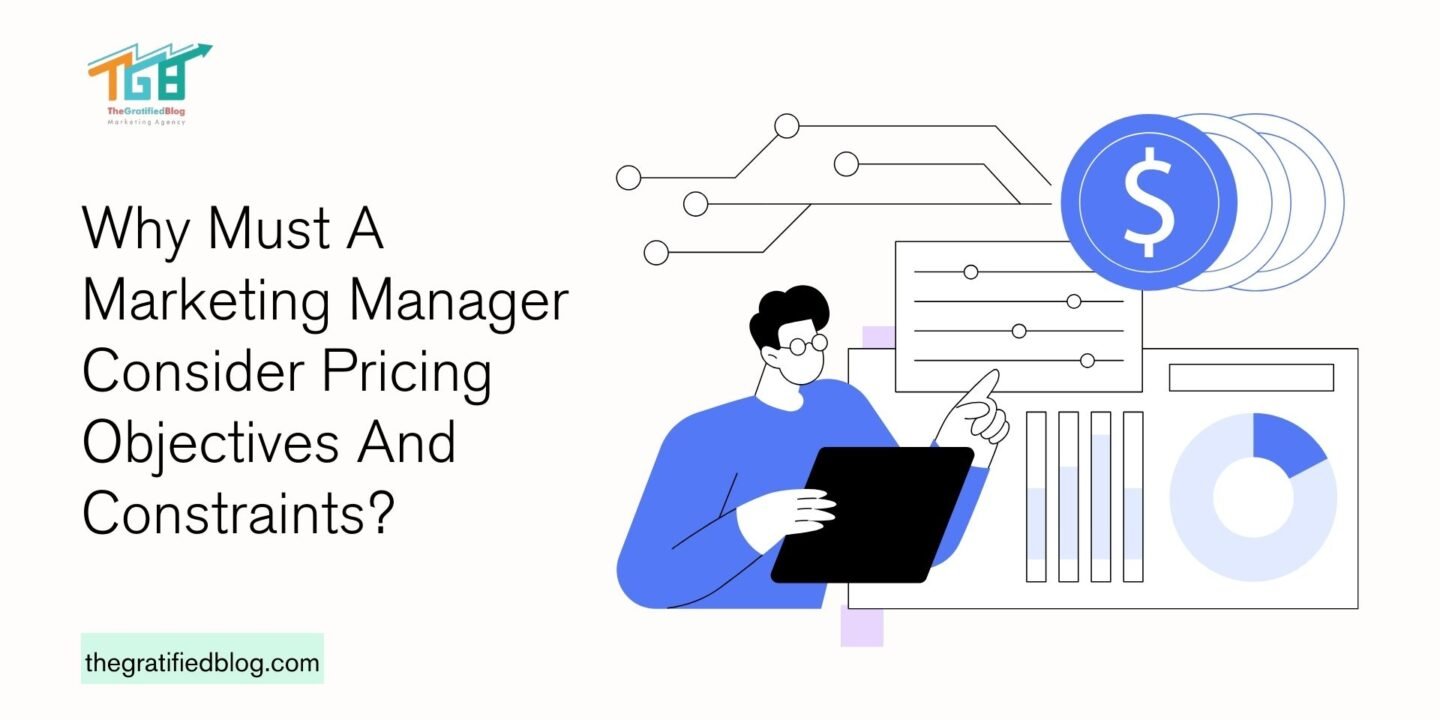
Marketing managers are the architects of brand success in the ever-evolving business landscape. They navigate a complex terrain of market dynamics, consumer behavior, and competitive pressures to steer their company toward profitability and growth. Setting the right price for a product or service is critical in their myriad decisions. But why is it so crucial for marketing managers to meticulously consider pricing objectives and constraints? In this article, “Why must a marketing manager consider pricing objectives and constraints?” we will delve deeper into why it is essential for a marketing manager to take pricing objectives and constraints into account when making pricing decisions.
Why Must A Marketing Manager Consider Pricing Objectives And Constraints?

Marketing managers are crucial in striking a delicate balance between pricing objectives and constraints. Managers can effectively set pricing objectives that align with the company’s overall goals by understanding the market dynamics and identifying constraints such as production costs, competitive pricing, and consumer willingness to pay.
Marketing managers must assess the impact of pricing decisions on profitability, market positioning, and customer perception. Through careful analysis and strategic planning, marketing managers can navigate pricing challenges and optimize pricing strategies to achieve sustainable growth and competitive advantage in the market.
Understanding Pricing Objectives
Pricing objectives are the goals a company sets for the prices of its products or services. These objectives vary in market conditions, business goals, and product positioning. Here are some common pricing objectives:
- Profit Maximization: The primary aim is to maximize profits, often achieved by setting prices at the point where marginal revenue equals marginal cost.
- Sales Revenue Maximization: Focusing on maximizing revenue rather than profit might involve setting lower prices to boost sales volume.
- Market Share Leadership: Setting prices strategically to gain a larger market share, even sacrificing short-term profits.
- Survival: In highly competitive or turbulent markets, setting prices to ensure the company’s survival rather than aiming for significant profits.
- Product Quality Leadership: Setting premium prices to reflect superior quality and create a perception of exclusivity.
Factors Influencing Pricing Constraints
While pricing objectives provide the overarching goals, marketing managers must also contend with various constraints that shape their pricing decisions:
- Costs: Understanding the costs associated with producing, marketing, and distributing the product is fundamental. Pricing below costs is unsustainable in the long run.
- Demand Elasticity: The degree to which demand for a product changes in response to price fluctuations influences pricing decisions. Inelastic demand allows for higher prices, whereas elastic demand requires more cautious pricing strategies.
- Competitive Landscape: Analyzing competitors’ pricing strategies is crucial. Pricing too high compared to competitors may result in loss of market share, while pricing too low may lead to price wars and diminished profitability.
- Legal and Ethical Considerations: Compliance with pricing regulations, avoiding price discrimination, and ensuring fairness and transparency are essential for maintaining trust and reputation.
- Consumer Perceptions: Understanding how consumers perceive value and price sensitivity helps set prices that align with customer expectations and willingness to pay.
Setting The Right Pricing Strategy For Your Product Or Service

Setting prices is a critical aspect that can make or break its success in the market. A marketing manager must consider various pricing objectives and constraints to ensure the pricing strategy aligns with the company’s overall goals. Factors such as value proposition, target market segment, and competitive landscape significantly determine the optimal pricing approach.
By carefully analyzing these aspects and aligning them with the pricing objectives and constraints, a marketing manager can create a pricing strategy that maximizes profitability and enhances the product or service’s positioning in the market. Here’s a step-by-step guide to help you determine the best pricing strategy:
- Understand Your Costs: Begin by calculating all costs associated with producing your product or delivering your service. This includes materials, labor, overhead, and any other expenses. Make sure to account for both fixed and variable costs.
- Know Your Market: Conduct thorough market research to understand your target audience, competitors, and product or service demand. Determine the price of similar products or services and how your offering compares quality, features, and value.
- Define Your Value Proposition: Clearly articulate the unique value your product or service provides to customers. This can include quality, convenience, exclusivity, or customer service.
- Set Pricing Objectives: Determine your pricing objectives, whether maximizing profit margins, gaining market share, achieving a particular revenue target, or positioning your product as a premium offering.
- Choose a Pricing Strategy: There are several pricing strategies you can consider:
- Cost-Plus Pricing: Add a markup to your costs to determine the selling price.
- Competitive Pricing: Set prices based on what your competitors are charging.
- Value-Based Pricing: Determine prices based on the perceived value to the customer.
- Penetration Pricing: Set low initial prices to penetrate the market quickly.
- Price Skimming: Set high prices initially and gradually lower them over time.
- Bundle Pricing: Offer discounts for purchasing multiple products or services together.
- Consider Dynamic Pricing: Depending on your industry and market conditions, you may also consider dynamic pricing, where prices change based on factors like demand, time of day, or customer segment.
- Test and Iterate: Pricing is not a one-time decision. Continuously monitor and analyze your pricing strategy, and be prepared to adjust it based on customer feedback, market changes, and business objectives.
- Communicate Value: Clearly communicate the value customers will receive for the price they pay. This can be done through marketing messages, product packaging, and customer testimonials.
- Monitor Competitors: Monitor your competitors’ pricing strategies and adjust your prices to remain competitive.
- Be Flexible: Be open to adjusting your pricing strategy as your business evolves, new competitors enter the market, or customer preferences change.
By following these steps and regularly evaluating your pricing strategy, you can set the right prices for your products or services to maximize profitability and customer satisfaction.
Meeting Profitability Goals With Pricing Objectives

A marketing manager must carefully consider pricing objectives and constraints to ensure the business meets its profitability goals. Setting the right pricing objectives, maximizing revenue, increasing market share, or achieving a profit margin can directly impact the company’s bottom line.
By aligning pricing strategies with these objectives and considering constraints, the marketing manager can implement pricing tactics that drive revenue and profitability for the business.
Ultimately, a well-thought-out pricing strategy can help the company achieve long-term financial success and sustain its competitiveness in the market. Meeting profitability goals with pricing objectives requires a strategic approach that balances revenue generation with cost management.
Here’s a step-by-step guide to achieving this:
- Understand Cost Structure: Before setting prices, you must understand all costs associated with your product or service. This includes direct costs (materials, labor) and indirect costs (overheads, digital marketing expenses, etc.). Knowing your cost structure helps in setting prices that cover these costs while leaving room for profit.
- Set Profit Margin Targets: Determine the desired profit margin for your products or services. This could be a percentage of the cost price or the selling price. Profit margin targets should be realistic and aligned with industry standards and your business objectives.
- Analyze Market and Competitors: Conduct market research to understand customer preferences, purchasing behavior, and competitors’ pricing strategies. This analysis helps identify pricing opportunities and potential competitive advantages.
- Value-Based Pricing: Instead of solely focusing on costs, consider the value your product or service provides to customers. Price is based on perceived value, considering quality, features, convenience, and brand reputation.
- Segmentation: Segment your market based on demographics, geography, or purchasing behavior. Implement different pricing strategies for each segment based on their willingness to pay and perceived value.
- Dynamic Pricing: Utilize dynamic pricing strategies to adjust prices in real-time based on demand, seasonality, competitor pricing, and other market factors. This allows you to maximize revenue and profitability by capturing value during peak demand periods.
- Promotions and Discounts: Strategically offer promotions, discounts, or bundling strategies to stimulate sales while maintaining profitability. Ensure that discounts are targeted and temporary to avoid eroding long-term profitability.
- Monitor and Adjust: Regularly monitor sales, profitability, and market conditions to assess the effectiveness of your pricing strategy. Adjust prices as needed to optimize profitability while remaining competitive in the market.
- Cost Optimization: Continuously seek opportunities to reduce costs without compromising product quality or customer satisfaction. Cost optimization initiatives improve profitability and may allow for more competitive pricing.
- Customer Feedback and Satisfaction: Solicit customer feedback regarding pricing perceptions and satisfaction levels. Use this information to refine pricing strategies and enhance customer value propositions.
Implementing these steps and continuously refining your pricing strategy based on market dynamics and business objectives can help you effectively meet profitability goals while ensuring competitiveness and customer satisfaction.
Overcoming Constraints To Achieve Pricing Objectives
In addition to considering market competition and consumer demand, marketing managers must also navigate various constraints that can impact pricing decisions. Production costs, legal regulations, and economic conditions can pose challenges when setting prices.
By proactively identifying and addressing these constraints, marketing managers can implement pricing strategies that align with the company’s objectives while remaining profitable. Overcoming constraints requires a comprehensive understanding of the market landscape and a strategic approach to pricing that balances profitability with competitiveness.
By overcoming these obstacles, marketing managers can maximize the potential for achieving their pricing objectives and driving long-term business success. Here are some typical constraints and strategies to overcome them:
- Cost Constraints: Identify ways to reduce production costs through efficiency improvements, renegotiating supplier contracts, or optimizing resource allocation.
- Competitive Constraints: Conduct a thorough analysis of competitors’ pricing strategies and adjust your pricing accordingly.
- Market Constraints: Segment the market and tailor pricing strategies to different customer segments based on their willingness to pay.
- Regulatory Constraints: Stay informed about relevant regulations and compliance requirements affecting pricing practices in your industry.
- Technological Constraints: Invest in technology to automate pricing processes, analyze data, and respond dynamically to market changes.
- Consumer Behavior Constraints: Conduct market research to understand consumer preferences, price sensitivity, and purchasing patterns.
- Internal Constraints: Align pricing objectives with overall business goals and secure buy-in from key organizational stakeholders.
Businesses can effectively achieve their pricing objectives and enhance profitability by addressing these constraints through strategic planning, innovation, market insights, and flexibility.
Utilizing Pricing Tactics To Maximize Revenue And Market Share
To achieve optimal results, marketing managers must employ effective pricing tactics aligning with their pricing objectives. By carefully analyzing the market landscape and consumer behavior, managers can determine the most suitable pricing strategy to maximize revenue and gain market share. Dynamic pricing, price bundling, and psychological pricing can strategically attract customers and enhance the company’s competitive position.
Marketing managers must continuously evaluate and adjust pricing tactics based on market dynamics and constraints to ensure sustained profitability and long-term success. A strategic approach to pricing can help businesses effectively meet their objectives and outperform competitors in the market.
The Role Of A Marketing Manager In Balancing Pricing Objectives And Constraints
A marketing manager plays a pivotal role in navigating the delicate balance between pricing objectives and constraints within an organization. Their primary responsibility involves aligning pricing strategies with broader business goals, such as profitability, market share, and brand marketing. They must analyze market dynamics, consumer behavior, and competitor pricing to set prices that maximize revenue while remaining competitive.
Additionally, they must consider various constraints, including production costs, legal regulations, and customer perceptions of value. By continuously assessing these factors, marketing managers can adjust pricing strategies to adapt to changing market conditions and meet the organization’s financial objectives.
Effective communication and collaboration with cross-functional teams are essential to ensure pricing decisions align with overall business objectives and resonate with target customers. Thus, the marketing manager is a strategic steward, orchestrating pricing initiatives to achieve sustainable growth and competitive advantage.
FAQs
Q1. What are pricing objectives, and why are they important for marketing managers?
Ans. Pricing objectives are the goals a company sets for the prices of its products or services. They are crucial for marketing managers as they provide a clear direction for pricing strategies, aligning them with broader business goals such as profit maximization, revenue growth, market share expansion, and maintaining competitiveness.
Q2. What factors influence pricing objectives?
Ans. Several factors influence pricing objectives, including market conditions, demand elasticity, competitive landscape, cost structure, product positioning, and company goals. Understanding these factors enables marketing managers to set realistic and achievable pricing objectives that drive business success.
Q3. How do pricing constraints impact pricing decisions?
Ans. Pricing constraints refer to limitations or factors that restrict a company’s pricing options. These constraints include production costs, demand elasticity, competition, legal regulations, ethical considerations, and consumer perceptions. Marketing managers must navigate these constraints to develop pricing strategies that maximize profitability while remaining competitive and compliant.
Q4. How can marketing managers balance pricing objectives and constraints effectively?
Ans. Balancing pricing objectives and constraints requires careful analysis, strategic thinking, and flexibility. Marketing managers must assess the trade-offs between different pricing objectives and evaluate the impact of various constraints on pricing decisions. They can optimize pricing strategies to achieve sustainable growth and profitability by aligning pricing strategies with business objectives and market realities.
Q5. What role does market research play in setting pricing objectives and navigating pricing constraints?
Ans. Market research informs pricing decisions by providing insights into consumer preferences, price sensitivity, competitor pricing strategies, and market dynamics. By conducting thorough market research, marketing managers can identify opportunities, anticipate challenges, and make informed decisions that align pricing objectives with market realities and constraints.
Conclusion
In conclusion, pricing objectives and constraints are crucial factors that a marketing manager must carefully consider when developing a pricing strategy. Setting the right pricing objectives helps align the pricing strategy with the overall business strategy and goals. On the other hand, constraints such as cost considerations, competitor pricing, and customer perceptions can impact pricing decisions and, ultimately, the product or service’s success in the market.
Pricing decisions are not made in isolation; they are deeply intertwined with a company’s overall marketing strategy and business objectives. Marketing managers can craft strategies that drive profitability, sustain competitive advantage, and resonate with customers, ultimately contributing to the business’s long-term success.








No Comments